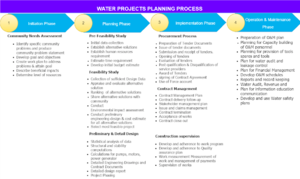Chapter Two: Project Planning
Arguably, planning of water supply projects is considered to be one of the most important stages in the design. Thus, it is strongly advised and emphasized that much time should be spent to undertake proper project planning. A proper project planning will ensure effective and efficient completion of the project successfully. In this chapter, project planning is presented in seven parts that are detailed below. These include:
- Planning considerations for water supply projects
- Project Planning steps
- Consulting the Integrated Water Resources Management and Development Plan
- Consult guideline for preparation of Water Safety Plan – resilient to climate change.
- Environmental and Social Impact Assessment (ESIA) and Strategic Environmental and Social Impact Assessment (SESIA) Compliance
- Potential Impacts of Climate Change on Water Supply Projects
- Participation of CBWSOs in Project Planning Stages
Chapter Two: Project Planning
2.1 Planning Considerations for Water Supply Projects Before commencement of any development of a water project, it is essential to conduct project planning. Planning is a process that should entail the following: • Undertake ESIA and SESIA studies, • Engagement and involvement of the local community to instill the ownership, provide the local knowledge, project buy in and accommodate community needs and requirements, • Assess safe and reliable yield or discharge and quality of water source, • Determination of the system layout, • Conduct design of the water supply project, • Implement the project in terms of construction, operation and maintenance, • Work out to obtain a sound and robust project financing.
It should be emphasized and stressed that collection of good quality, reliable, credible and enough data should be given high priority at all stages of project implementation. Population projection methods and their relevance for rural and urban settings or areas as recommended by the National Bureau of Statistics (NBS) have to be evaluated. Demographic features such as social and economic conditions have to be studied before design projections can be established. Also, water source reliability should be carried out before any further stage of project implementation. 2.2 Project Planning Steps Project planning involves a series of steps that determine how project goals will be achieved. The goals may be solicited from the existing community or a strategic plan. In an event that there is not any plan, project plans can be developed through community meetings and gatherings, councils or board meetings, special focused group discussions or other planning processes.
The main steps of project planning include: Step 1: Initiation Step 2: Pre-feasibility study Step 3: Feasibility study Step 4: Preliminary and Detailed Design Step 5: Project phasing Step 6: Procurement Step 7: Implementation/Construction Step 8: Operation and Maintenance (Management) Step 9: Performance Monitoring
The planning of water supply projects can be represented diagrammatically by a step wise planning cycle as shown in Figure 2.1.
2.3 Pump Protection The following sections provide a brief description of each of the twelve project planning steps.
2.3.1 Initiation Initiation or sometimes referred to as triggering stage, is a step where initial ideas of the project are presented. Community mobilization through awareness raising is conducted at this stage. The whole idea is to inform the community on the start of the project, solicit community input and knowledge about the project area. Project common understanding is also expected to be realized at this step.
The outcome of this stage of planning is to acquire an understanding of the community conditions and identify problems that prevent the community from achieving its long-range goals. Community conditions which must be collected includes aspects of the community such as: • Its geographic location, • Demographics, • Ecosystem, • History,e.t.c
The data collection for the above information should employ community assessment methods.
Previous Page: Chapter One: Introduction << >> Next Page: Chapter Three: Water Sources Analysis
